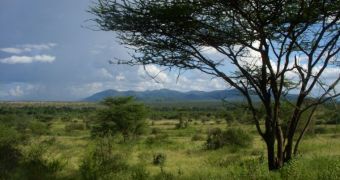Scientists conducting isotopic analysis of ancient African soils have determined that our earliest ancestors and their ape cousins spent the past 6 millions years or so evolving in tree-dotted savannas.
This is the type of landscape that prevailed throughout the vast majority of east Africa, where the first hominids are thought to have evolved from a common ancestor it shared with apes. Researchers came to this conclusion after they analyzed tree cover in this region.
By using isotopic analysis, the investigators were able to figure out how much shade was available at the time. This measure can be calculated by analyzing just how many trees were available in the savannas, and then using observations of the modern word to extrapolate a result.
The work – sponsored by the US National Science Foundation (NSF) and the Leakey Foundation – was conducted by investigators at the University of Utah. The team was led by geochemist Thure Cerling.
He is also the lead author of a new paper detailing the findings, which appears in the latest issue of the top scientific journal nature. The study is entitled “Woody cover and hominin environments in the past 6 million years.”
“We've been able to quantify how much shade was available in the geological past. It shows there have been open habitats for the last six million years in the environments in East Africa where some of the most significant early human fossils were found,” the expert adds.
“Wherever we find human ancestors, we find evidence for open habitats similar to savannas – much more open and savanna-like than forested,” the investigator goes on to say. Understanding the role savannas played in human evolution is essential towards making sense of our species' history.
The development of upright walking, increases brain size and learning how to use tools may have all been influenced by the landscape in which the earliest hominins lived, the research team argues.
Cerling says that one of the most significant problems with conducting this type of studies has been the imprecise definition of what a savanna is. The term has been used to describe “virtually everything between completely open grasslands and anything except a dense forest,” he says.
“The development of a paleo-shade proxy for soil temperature and woody cover, and its application to ancient fossil sites, reinforces the long-held theory that the roots of human origins are in the open grassland/savanna environments of East Africa,” H. Richard Lane explains.
The expert holds an appointment as a program director in the NSF Division of Earth Sciences (DES).

 14 DAY TRIAL //
14 DAY TRIAL //